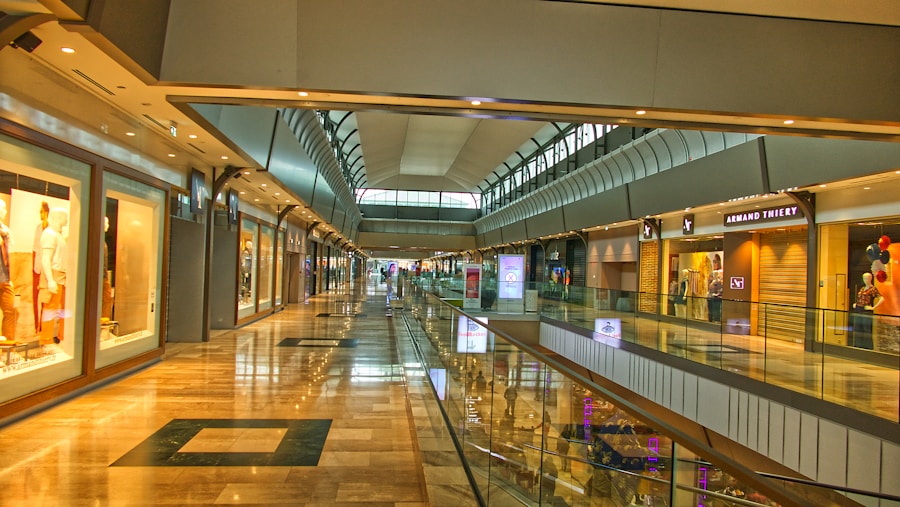Shopping centers have undergone a remarkable transformation since their inception, evolving from simple marketplaces to complex retail ecosystems that cater to a diverse range of consumer needs. The concept of a centralized location for shopping can be traced back to ancient civilizations, where bazaars and marketplaces served as hubs for trade and social interaction. However, the modern shopping center as we know it began to take shape in the mid-20th century, particularly in the United States, with the rise of suburban living and the automobile culture.
The first enclosed shopping mall, Southdale Center, opened in Edina, Minnesota, in 1956, setting a precedent for future developments. As consumer behavior shifted and urbanization increased, shopping centers adapted to meet the changing demands of society. The introduction of anchor stores, such as department stores and supermarkets, provided a draw for shoppers, while smaller specialty shops filled in the gaps.
Over the decades, shopping centers have diversified their offerings to include entertainment options, dining experiences, and even fitness facilities. This evolution reflects broader societal trends, including the rise of leisure culture and the desire for convenience. Today’s shopping centers are not merely places to purchase goods; they are multifaceted environments designed to enhance the overall consumer experience.
Key Takeaways
- Shopping centers have evolved over time to incorporate technology, sustainability, personalization, and community spaces.
- Technology has significantly enhanced the shopping experience, with the rise of virtual and augmented reality transforming the way consumers interact with products.
- Sustainability and eco-friendly practices are becoming increasingly important in retail, with many shopping centers implementing green initiatives to reduce their environmental impact.
- Personalization and customization are key trends in shopping centers, as retailers strive to create unique and tailored experiences for their customers.
- Community spaces play a vital role in shopping centers, providing a place for people to gather, socialize, and engage in activities, contributing to the overall shopping experience.
Technology and the Shopping Experience
Understanding Consumer Behavior
One significant advancement is the use of data analytics to understand shopping patterns and preferences. Retailers can now track customer behavior in real-time, allowing them to tailor promotions and inventory to meet specific demands. For instance, loyalty programs that utilize customer data can offer personalized discounts based on previous purchases, enhancing customer satisfaction and encouraging repeat visits.
A Seamless Omnichannel Experience
Moreover, technology has facilitated a seamless omnichannel shopping experience. Consumers can browse products online, check availability in-store, and even reserve items for pickup. This integration of online and offline shopping has become increasingly important as consumers seek convenience and flexibility.
Enhancing the Shopping Experience
Retailers are investing in mobile apps that provide features such as virtual try-ons or augmented reality experiences that allow customers to visualize products in their own spaces before making a purchase. These technological innovations not only enhance the shopping experience but also foster a deeper connection between consumers and brands.
Sustainability and Eco-Friendly Practices in Retail

As awareness of environmental issues grows, sustainability has become a critical focus for shopping centers and retailers alike. The retail industry is one of the largest contributors to global waste and carbon emissions, prompting many businesses to adopt eco-friendly practices. Shopping centers are increasingly incorporating sustainable design principles into their architecture and operations.
For example, many new developments feature energy-efficient lighting, water-saving fixtures, and green roofs that promote biodiversity while reducing energy consumption. In addition to building practices, retailers are also rethinking their supply chains to minimize environmental impact. This includes sourcing materials responsibly, reducing packaging waste, and implementing recycling programs within stores.
Some shopping centers have even established partnerships with local farmers and artisans to promote sustainable products and support the local economy. By prioritizing sustainability, shopping centers not only appeal to environmentally conscious consumers but also contribute positively to their communities and the planet.
Personalization and Customization in Shopping Centers
| Metrics | Statistics |
|---|---|
| Percentage of shoppers who prefer personalized shopping experiences | 63% |
| Number of shopping centers offering personalized recommendations | Over 50% |
| Percentage increase in sales due to personalized promotions | 28% |
| Number of shoppers who are willing to share personal data for customized experiences | 72% |
The demand for personalized shopping experiences has surged in recent years as consumers seek products and services tailored to their individual preferences. Shopping centers are responding by creating environments that foster customization at various levels. Retailers are leveraging technology to gather data on customer preferences and behaviors, allowing them to offer personalized recommendations and experiences.
For instance, some clothing stores utilize customer profiles to suggest items based on past purchases or browsing history. Beyond product recommendations, shopping centers are also enhancing the physical environment to cater to diverse consumer needs. This includes creating flexible spaces that can be adapted for different events or activities, such as pop-up shops or community gatherings.
By offering customizable experiences, shopping centers can engage customers on a deeper level, fostering loyalty and encouraging repeat visits. The emphasis on personalization reflects a broader trend in retail where consumers increasingly expect brands to understand their unique preferences and deliver tailored solutions.
The Rise of Virtual and Augmented Reality in Retail
Virtual reality (VR) and augmented reality (AR) technologies are making significant inroads into the retail sector, transforming how consumers interact with products and brands. These immersive technologies provide unique opportunities for shopping centers to enhance the customer experience by offering interactive elements that engage shoppers in new ways. For example, AR applications allow customers to visualize how furniture would look in their homes or how clothing would fit without trying it on physically.
This not only enhances the shopping experience but also reduces the likelihood of returns. Shopping centers are also utilizing VR experiences to create memorable brand interactions. Some retailers have developed VR showrooms where customers can explore products in a virtual environment before making a purchase decision.
This innovative approach not only captivates consumers but also provides valuable insights into their preferences and behaviors. As VR and AR technologies continue to evolve, they will likely play an increasingly prominent role in shaping the future of retail by creating immersive experiences that blur the lines between physical and digital shopping.
The Importance of Community Spaces in Shopping Centers

Community Spaces Serve Multiple Purposes
These community spaces serve multiple purposes: they provide venues for local events, host farmers’ markets or art fairs, and create opportunities for social interaction among shoppers. By cultivating a sense of community within their environments, shopping centers can enhance customer loyalty and attract foot traffic beyond traditional shopping hours.
Enhancing the Shopping Experience
This emphasis on community not only enriches the shopping experience but also positions shopping centers as integral parts of their local neighborhoods.
The Role of Artificial Intelligence in Retail
Artificial intelligence (AI) is revolutionizing various aspects of retail operations, from inventory management to customer service. In shopping centers, AI technologies are being employed to streamline processes and enhance the overall consumer experience. For instance, AI-driven chatbots are increasingly used on retail websites and mobile apps to provide instant customer support, answering queries about product availability or store hours without human intervention.
Moreover, AI algorithms analyze vast amounts of data to predict consumer behavior and optimize inventory levels accordingly. This predictive analytics capability allows retailers within shopping centers to ensure that popular items are always in stock while minimizing excess inventory that could lead to markdowns or waste. Additionally, AI can personalize marketing efforts by analyzing customer data to deliver targeted promotions based on individual preferences.
As AI continues to advance, its integration into retail will likely deepen, further enhancing operational efficiency and customer engagement.
The Future of Shopping Centers
The future of shopping centers is poised for continued evolution as they adapt to changing consumer preferences and technological advancements. As retail landscapes shift towards more experiential offerings, shopping centers will need to embrace innovation while remaining attuned to sustainability and community engagement. The integration of technology will play a pivotal role in shaping these environments, enabling personalized experiences that resonate with consumers on a deeper level.
Furthermore, as society increasingly values sustainability and social responsibility, shopping centers that prioritize eco-friendly practices will likely gain a competitive edge. By fostering community connections through shared spaces and events, these retail hubs can become vital components of local neighborhoods rather than mere commercial entities. Ultimately, the future of shopping centers will hinge on their ability to create dynamic environments that blend retail with meaningful experiences—ensuring they remain relevant in an ever-changing marketplace.












